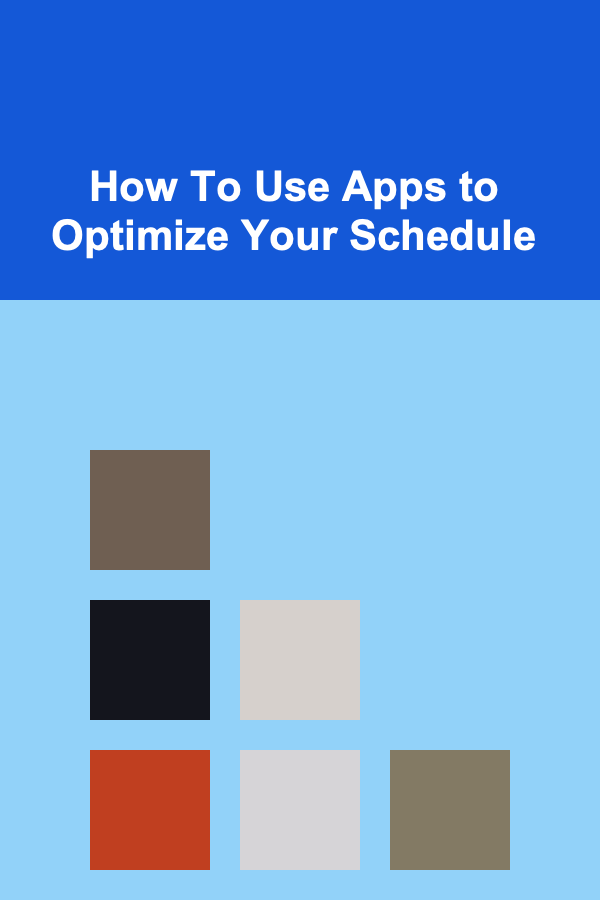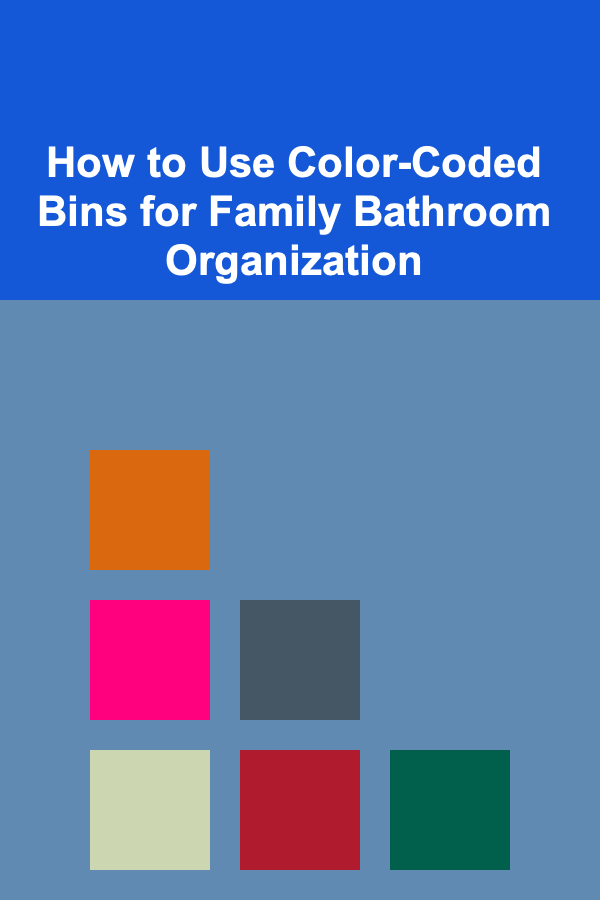
How To Use Apps to Optimize Your Schedule
ebook include PDF & Audio bundle (Micro Guide)
$12.99$7.99
Limited Time Offer! Order within the next:

In today's fast-paced world, time management has become an essential skill. With an ever-increasing number of tasks and responsibilities, it can be challenging to stay on top of everything. Luckily, technology has made this easier than ever before. Apps, which have become a vital part of our daily lives, offer efficient solutions to streamline tasks and optimize our schedules.
Whether you are a student, professional, or entrepreneur, apps can help you plan your day, stay organized, and ultimately improve productivity. This article explores the various types of apps that can help optimize your schedule and provides strategies to maximize their potential.
Understanding the Importance of Scheduling
Before diving into the specifics of how apps can optimize your schedule, it's important to understand why scheduling is crucial. Effective scheduling allows you to:
- Increase Productivity: By managing time wisely, you can focus on what matters most, avoiding distractions and multitasking that can reduce your overall output.
- Reduce Stress: A well-organized day can alleviate feelings of being overwhelmed. With a clear roadmap of tasks, you can approach your responsibilities with a sense of control and purpose.
- Balance Work and Life: Scheduling allows you to allocate time for both work and personal activities, ensuring that neither side is neglected.
- Achieve Goals: Whether personal or professional, having a schedule helps you break down large goals into manageable tasks, bringing you closer to your objectives.
Now that we understand the benefits of scheduling, let's look at how apps can aid in this process.
Types of Apps to Optimize Your Schedule
There are numerous types of apps available for time management, each with unique features. Below are the most common types and how they can help optimize your schedule.
1. Calendar Apps
Calendar apps are essential for organizing your time. These apps allow you to schedule events, meetings, and appointments, helping you keep track of important deadlines and tasks. Some of the most popular calendar apps include:
- Google Calendar: Google Calendar is one of the most widely used calendar apps. It allows you to create events, set reminders, and integrate with other Google services, such as Gmail and Google Meet, making it ideal for both personal and professional scheduling.
- Microsoft Outlook Calendar: Outlook Calendar integrates seamlessly with Microsoft Office tools and is ideal for professionals who use Microsoft's ecosystem for their daily tasks.
- Apple Calendar: For users within the Apple ecosystem, the Apple Calendar app is a natural choice. It offers the ability to create events, share calendars, and sync across all Apple devices.
Key Features to Look For:
- Time Zone Support: If you work in different time zones, make sure your calendar app offers time zone support to avoid confusion.
- Event Reminders: Set up alerts to receive reminders for your upcoming appointments.
- Recurring Events: Many calendar apps support recurring events, which is helpful for regularly scheduled meetings or tasks.
2. Task Management Apps
Task management apps are designed to help you break down your larger tasks into smaller, more manageable ones. These apps allow you to create to-do lists, set deadlines, and track your progress. Some popular task management apps include:
- Todoist: Todoist allows you to create tasks and subtasks, assign deadlines, and prioritize your to-do list. It also syncs across multiple devices, making it easy to stay on top of your tasks no matter where you are.
- Trello: Trello is a visual task management tool that uses boards, lists, and cards to help you organize and prioritize tasks. It's particularly useful for collaborative projects, as multiple users can work on the same board in real time.
- Asana: Asana is a project management tool that allows you to break down tasks, assign them to team members, and track progress. It's perfect for teams but can also be used by individuals who want to organize their tasks.
Key Features to Look For:
- Task Prioritization: Prioritize tasks based on importance or deadlines to ensure that you are working on the most critical items.
- Due Dates and Notifications: Set due dates for tasks to ensure timely completion. Enable notifications to stay reminded of upcoming deadlines.
- Subtasks: Break tasks down into smaller subtasks to make them more manageable and trackable.
3. Time-Tracking Apps
Time-tracking apps allow you to monitor how much time you spend on different tasks throughout the day. These apps provide valuable insights into how efficiently you're managing your time and can help identify areas where you might be wasting time. Popular time-tracking apps include:
- Toggl: Toggl is a simple and intuitive time-tracking tool that tracks how much time you spend on various tasks. It's useful for freelancers and anyone who wants to optimize their time.
- RescueTime: RescueTime works in the background of your computer or mobile device to track how much time you spend on different applications and websites. It gives you a detailed report, helping you identify time-wasting activities.
- Clockify: Clockify is a free time-tracking tool that allows users to track billable hours and monitor time spent on projects. It's a great choice for businesses and freelancers.
Key Features to Look For:
- Automatic Tracking: Some apps offer automatic tracking, which allows you to monitor your time without manually starting and stopping the timer.
- Reports: Time-tracking apps often provide reports that break down how much time you spend on different tasks or categories, helping you identify areas for improvement.
- Integration: Some time-tracking apps integrate with other tools like task managers or calendar apps to provide a holistic view of your schedule.
4. Focus and Pomodoro Apps
Focus apps help you stay on task by limiting distractions and encouraging you to focus on one task at a time. The Pomodoro Technique is one of the most well-known time management methods, where you work in intervals (typically 25 minutes) followed by short breaks. Popular focus and Pomodoro apps include:
- Focus Booster: Focus Booster uses the Pomodoro Technique to help you stay productive by encouraging focused work sessions followed by breaks. It's a simple and effective way to stay on track.
- Forest: Forest is a focus app that helps you stay off your phone while you work. When you start a work session, a virtual tree grows, but if you exit the app, the tree dies. Over time, you can grow a virtual forest as a record of your productive work sessions.
- Be Focused: Be Focused is a Pomodoro timer app that allows you to set tasks and work intervals. It also lets you track the number of intervals you complete.
Key Features to Look For:
- Timer: A good focus app should have a timer feature that tracks your work sessions and break periods.
- Progress Tracking: Track your productivity over time and see how many Pomodoros (work intervals) you complete.
- Customizable Intervals: Some apps let you customize the length of your work intervals and breaks, allowing you to tailor the experience to your preferences.
5. Habit-Tracking Apps
Building positive habits can significantly enhance your time management skills. Habit-tracking apps help you monitor your progress toward building and maintaining habits. These apps keep you motivated and provide reminders to help you stay consistent. Some popular habit-tracking apps include:
- Habitica: Habitica turns habit building into a game by rewarding you with points and achievements as you complete tasks and habits.
- Streaks: Streaks is a simple yet effective habit-tracking app that lets you track up to 12 habits at a time. The goal is to build long streaks of consistent behavior.
- HabitBull: HabitBull allows you to track habits, set reminders, and view detailed progress charts. It's highly customizable and can be used for building both short-term and long-term habits.
Key Features to Look For:
- Reminders: Set daily reminders to help you stay on track with your habits.
- Progress Tracking: View visual progress charts to track how consistent you've been with your habits.
- Motivation Tools: Many apps provide motivational tools like rewards or challenges to help you stay committed to your habits.
Strategies to Maximize Your Scheduling Apps
While having the right apps is important, using them effectively is equally crucial. Here are some strategies to maximize the potential of your scheduling apps:
1. Set Clear Goals
Before you begin using apps to optimize your schedule, it's important to set clear goals. Understand what you want to achieve with your scheduling efforts. Whether it's improving productivity, reducing stress, or achieving specific personal or professional goals, having a clear objective will help you use your apps more effectively.
2. Use Apps in Tandem
Rather than relying on a single app, use multiple apps in tandem to cover different aspects of your scheduling. For example, you might use a calendar app for scheduling events and meetings, a task manager for organizing your to-do list, and a time tracker to monitor your productivity. Integration between apps can streamline your workflow and provide a more holistic approach to scheduling.
3. Prioritize Tasks
Effective scheduling requires you to prioritize tasks. Use task management apps to categorize tasks by importance and urgency. Consider using the Eisenhower Matrix, a tool that helps you prioritize tasks by urgency and importance. Apps like Todoist and Asana allow you to assign priorities to tasks, making it easier to focus on what matters most.
4. Schedule Breaks
Don't forget to schedule regular breaks throughout the day. Studies show that taking breaks can help improve focus and productivity. Use your calendar or focus app to schedule short breaks between work sessions. The Pomodoro Technique is an excellent way to incorporate breaks into your day.
5. Review and Adjust Regularly
Your schedule should be flexible enough to accommodate changes and unexpected events. Regularly review your schedule and adjust it as needed. Time-tracking apps can help you identify areas where you might be spending too much time, allowing you to make adjustments to improve efficiency.
6. Stay Consistent
Consistency is key to effective scheduling. Use habit-tracking apps to build consistent scheduling habits. The more consistently you follow your schedule, the more likely you are to experience improvements in productivity and time management.
Conclusion
Scheduling is an essential part of managing our daily tasks and responsibilities. By using apps designed for time management, task organization, and focus, we can optimize our schedules, reduce stress, and increase productivity. The key is to choose the right apps for your needs and implement strategies that help you stay organized, focused, and consistent. With the right tools and approach, you can take control of your time and achieve your personal and professional goals.

How to Create Themed Displays for Your Hobby Items
Read More
How to Develop a Mindful Approach to Exercise
Read More
How to Navigate Rental Property Laws and Regulations
Read More
How to Use Color-Coded Bins for Family Bathroom Organization
Read More
How to Create Engaging Infographics: A Comprehensive Guide
Read More
How to Prepare a Tax Checklist for Freelancers
Read MoreOther Products

How to Create Themed Displays for Your Hobby Items
Read More
How to Develop a Mindful Approach to Exercise
Read More
How to Navigate Rental Property Laws and Regulations
Read More
How to Use Color-Coded Bins for Family Bathroom Organization
Read More
How to Create Engaging Infographics: A Comprehensive Guide
Read More